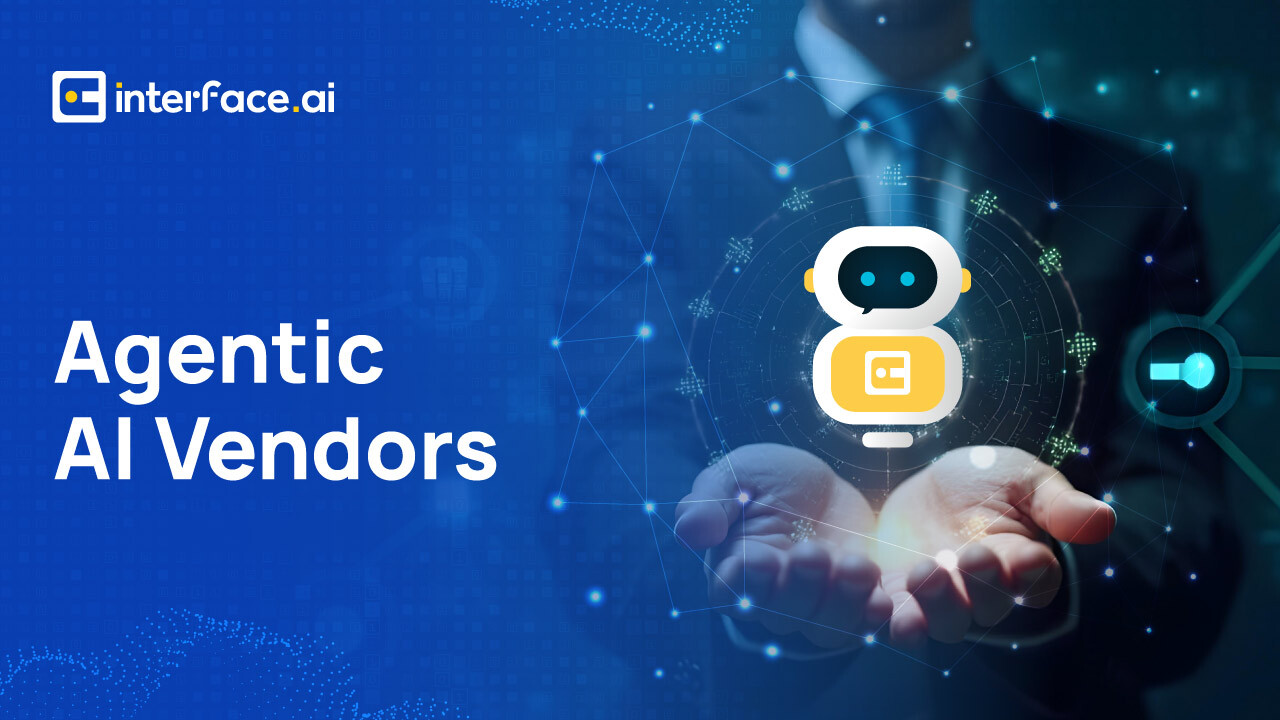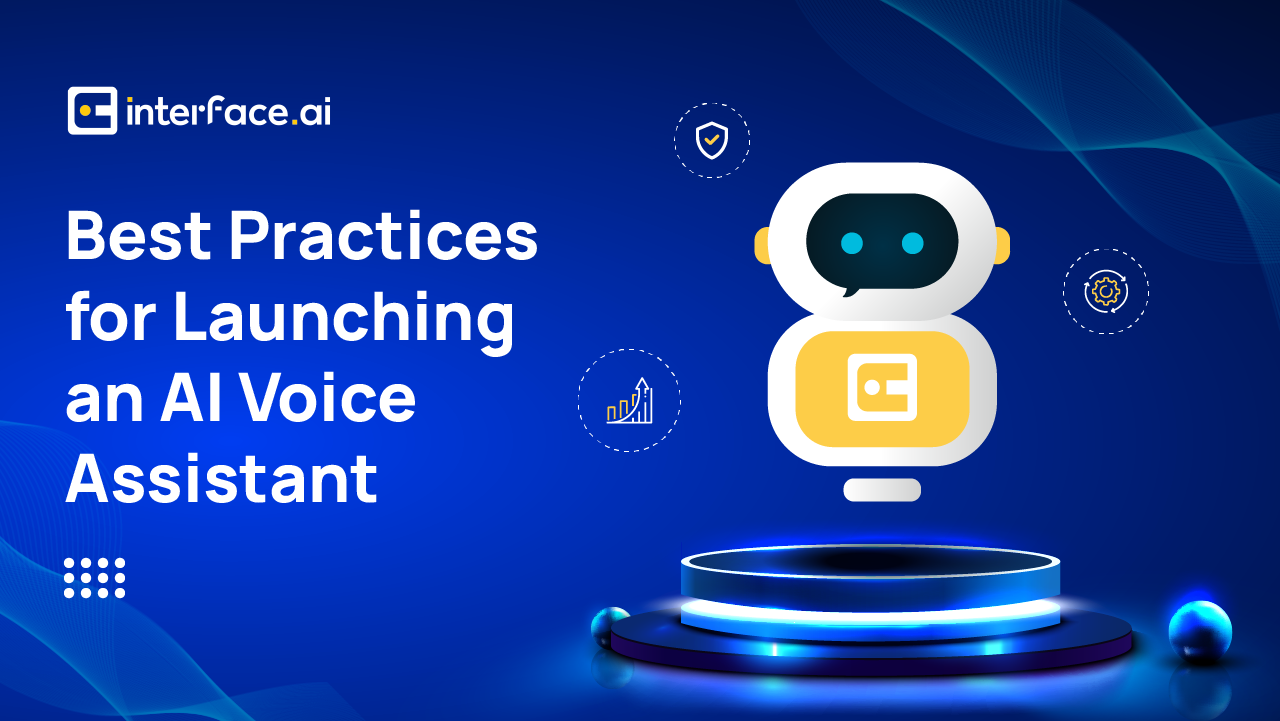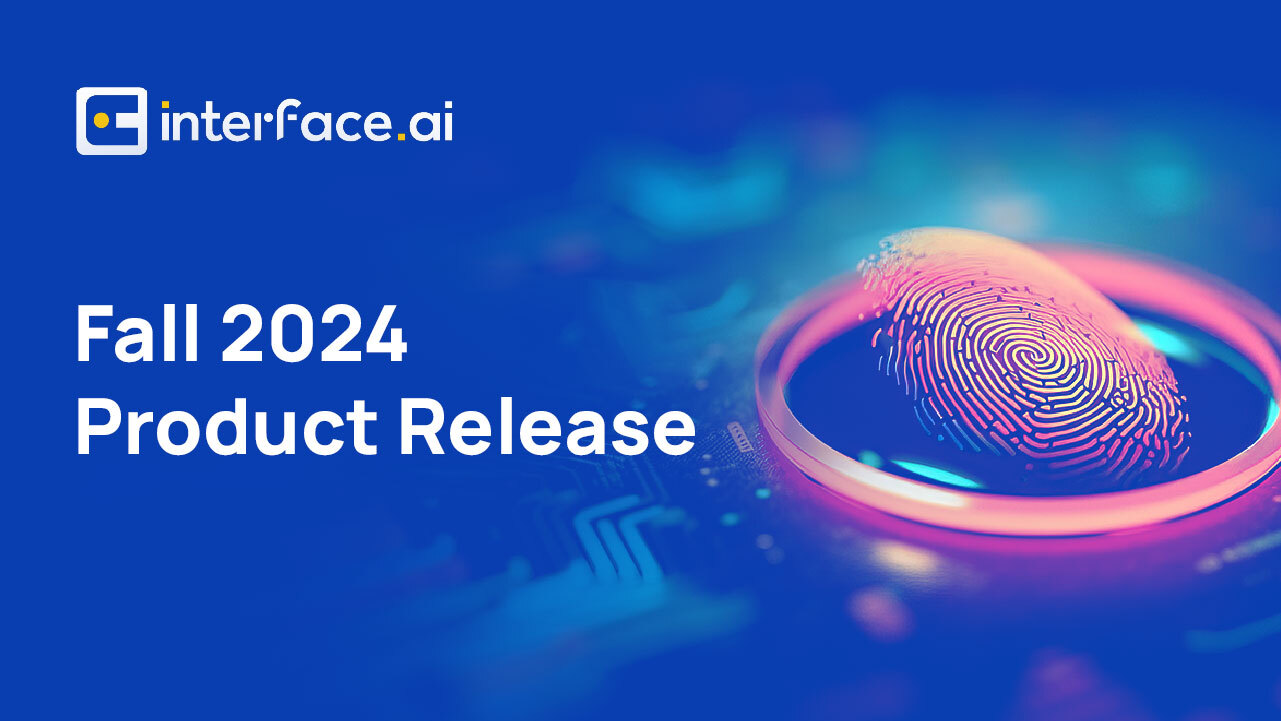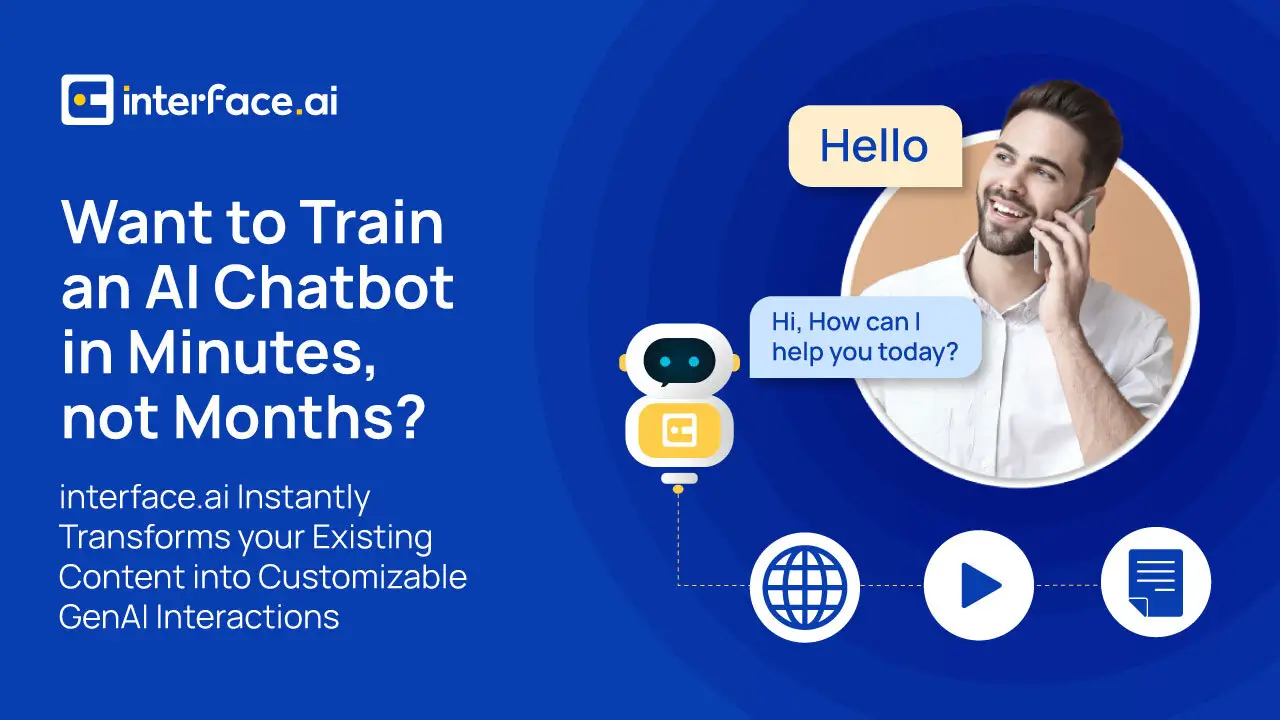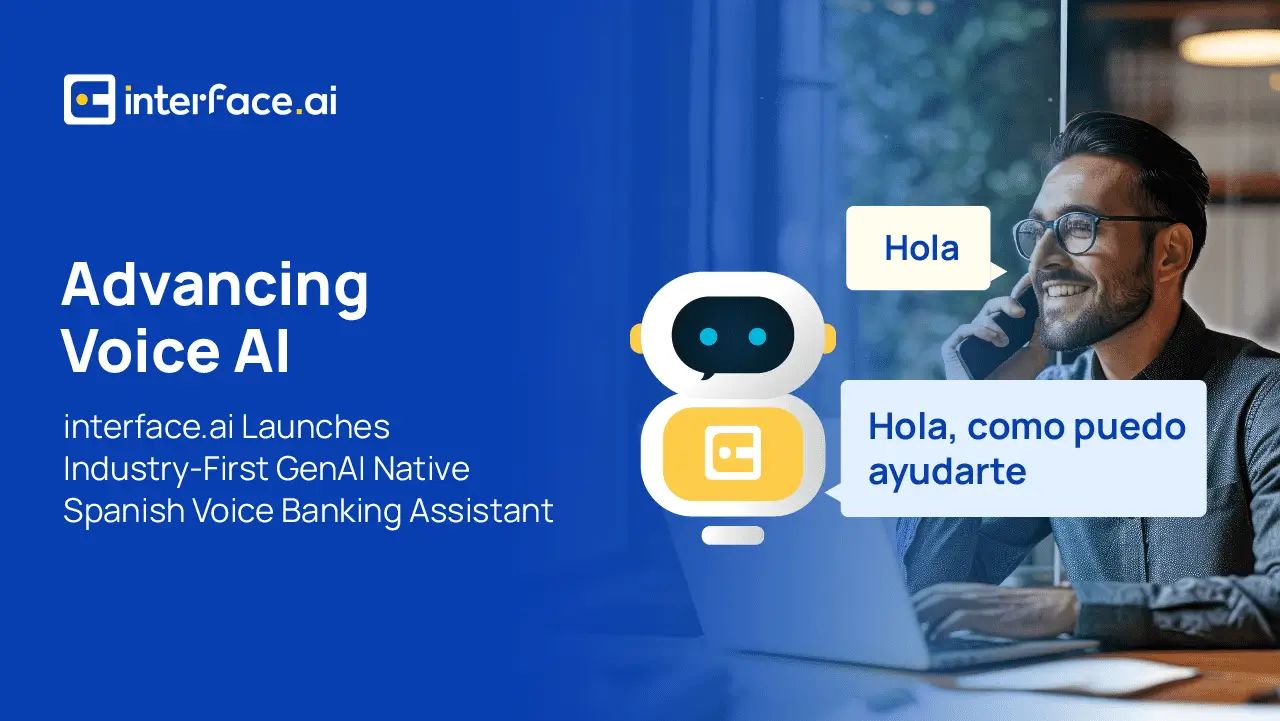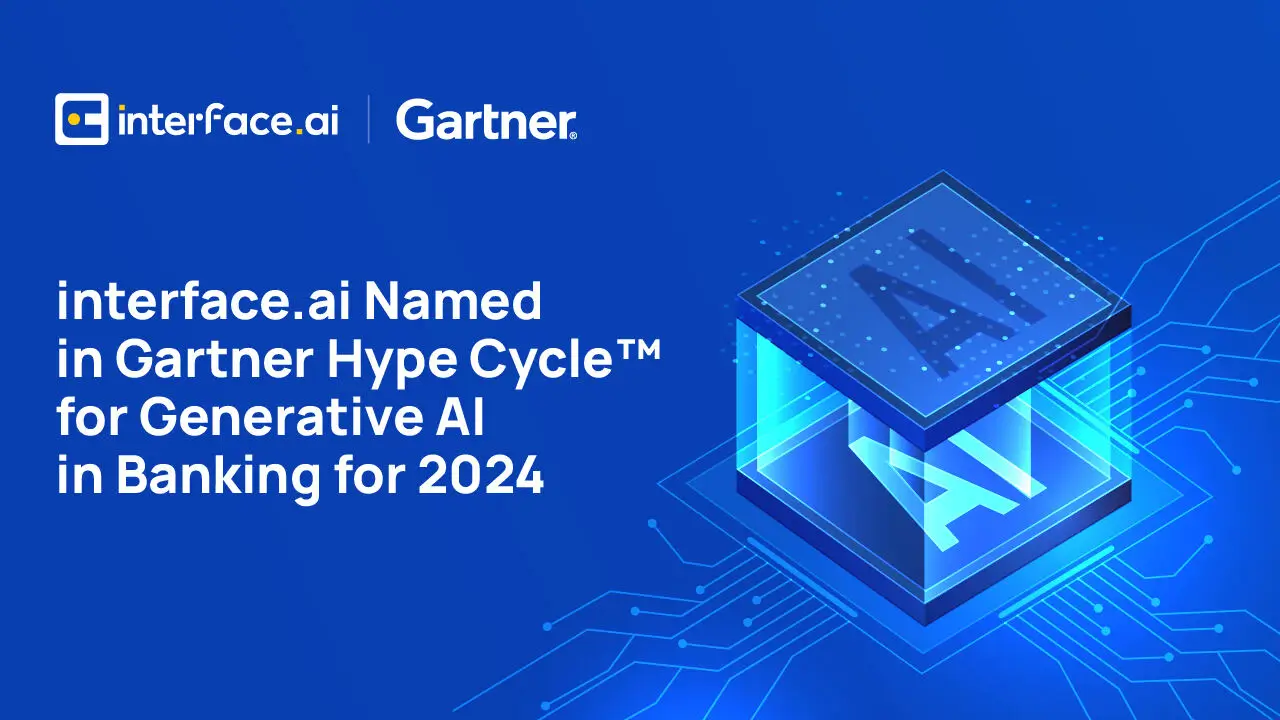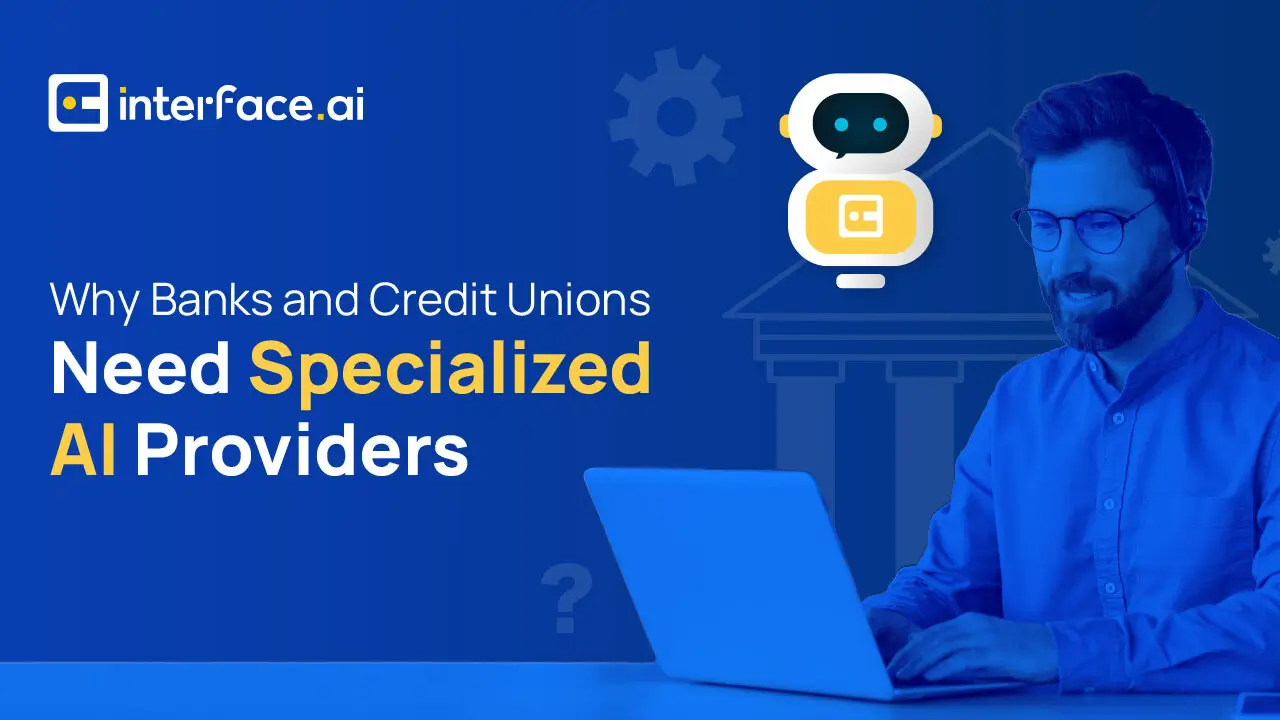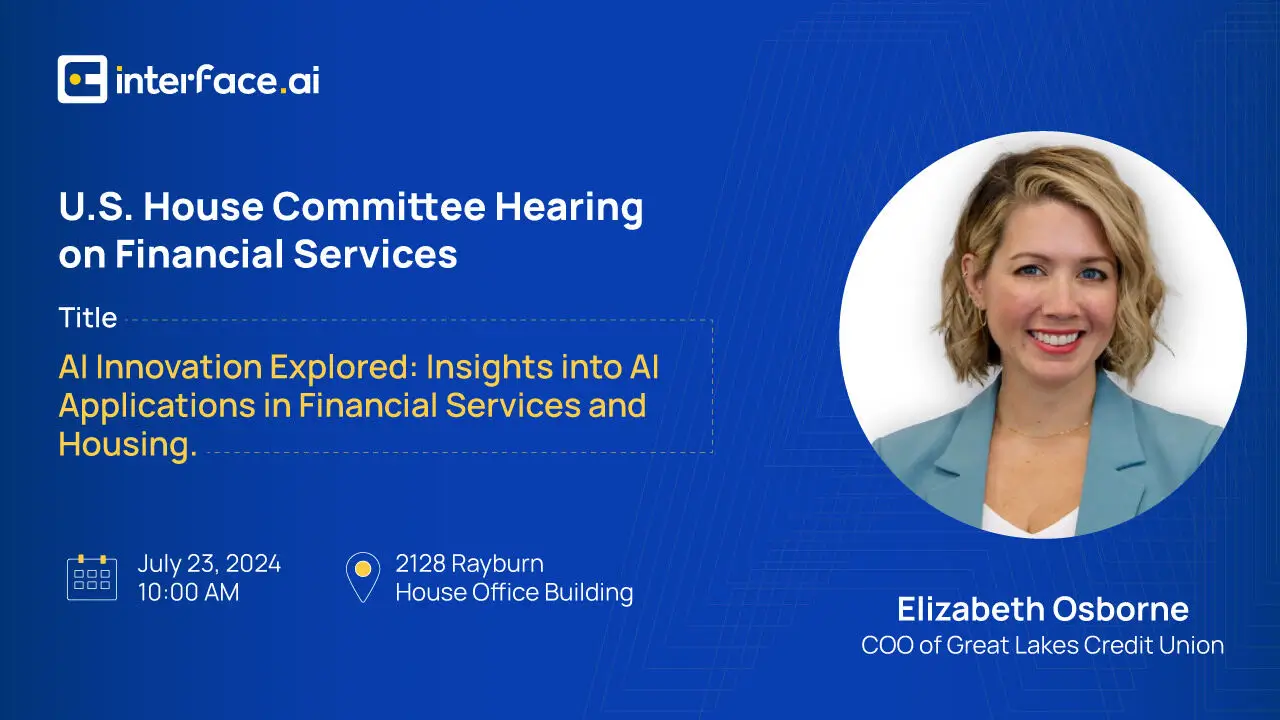
COO of Great Lakes Credit Union Addresses U.S. Congressional Hearing on Success of interface.ai Voice AI
🚀 Watch the on-demand stream of the U.S. Congressional hearing on AI Innovation in Financial Services and hear Elizabeth Osborne, COO of Great Lakes Credit Union, share insights on the impact of interface.ai’s Voice AI assistant. 🚀
This hearing, hosted by the U.S. Congressional Committee on Financial Services, delved into how AI is revolutionizing the financial services and housing sectors. Elizabeth Osborne shared her insights on leveraging interface.ai’s Voice and Chat AI to enhance operations and member experience, including the impact on call handling rates, abandonment rates, and member satisfaction.
In her testimony, Elizabeth Osborne remarked that:
“Since the introduction of Olive [interface.ai’s Voice AI Assistant], GLCU has realized remarkable results in terms of member satisfaction, member call center performance, and employee engagement…Olive consistently handles over 60% of total inbound calls during business hours and over 75% of all calls after business hours. This compared to less than 25% handling rate with our previous telephone banking solution (which did not include AI technology). Olive has increased the number of calls fully serviced by the virtual assistant by over 200% since launch.”
Witnesses included:
– Mr. John Zecca, Executive Vice President, Global Chief Legal, Risk and Regulatory Officer, NASDAQ
– Mr. Ondrej Linda, Senior Director, Personalization AI, Zillow
– Ms. Elizabeth Osborne, Chief Operations Officer, Great Lakes Credit Union
– Mr. Frederick Reynolds, Deputy General Counsel for Regulatory Legal and Chief Compliance Officer, FIS Global
– Mr. Vijay Karunamurthy, Chief Technology Officer, Scale AI
– Ms. Lisa Rice, President and CEO, National Fair Housing Alliance
Key Legislative Proposals Discussed:
– H.J.Res.___: Expressing the important role the Financial Services Committee plays in overseeing AI in the financial services and housing industries.
– H.R. 5808, the “Preventing Deep Fake Scams Act”: Establishes a task force to issue a report on protecting banks and credit unions from AI-related fraud.
– H.R. 7781, the “Artificial Intelligence Practices, Logistics, Actions, and Necessities Act”: Directs key departments to report on the risks of AI in financial crimes.
– H.R. ___: Requires a study on standardized descriptions for vendor-provided AI systems.
Full Transcript of the Opening Remarks:
Opening/Introduction
Good morning, Chairman McHenry, Ranking Member Waters, and Members of the Committee. I am Elizabeth Osborne, Chief Operations Officer (COO) of Great Lakes Credit Union (GLCU), headquartered in Bannockburn, Illinois. Founded in 1938, GLCU is a $1.6 billion not-for-profit, low-income designated, HUD-certified financial cooperative that serves over 90,000 members in Chicago, Illinois, and surrounding areas. GLCU is an innovative credit union, committed to financial empowerment for its members and diverse communities. We are active nationally as a member of America’s Credit Unions. We are also proud of our track record of service to our members, which has seen us recognized for our DEI and financial literacy efforts. GLCU is one of fewer than 10 credit unions in the entire country to have a HUD-Approved Housing and Financial Counseling program, which is available to both its members and communities at large. At the heart of our mission is the credit union philosophy of “people helping people.” At GLCU that includes state-of-the-art technology and a range of financial solutions in place for one goal: to enable our members to live life on their terms.
While credit unions nationwide have continued to grow over the past few years, now serving over 140 million consumers, the vast majority are small institutions with limited resources. As a matter of fact, the largest bank has 20 times the assets of the largest credit union. That is why tapping into financial technologies such as AI is so important to the credit union industry. It allows us to use this technology to better serve our members and meet their needs with the same ability of larger financial institutions. I appreciate the opportunity to be here today to talk to you about how AI has helped GLCU and other credit unions do just that.
Uses and Opportunities of AI
Credit unions are committed to using AI safely, securely, and with the goal of helping their members meet their financial needs. In general, the type of AI deployed by credit unions is a type of “narrow” AI derived from supervised machine learning (ML).1 AI built using supervised machine learning tends to exhibit predictable characteristics since the foundation of these models consists of labeled training data grounded to a baseline expectation for a correct output. AI models that require close supervision during training can utilize static data, meaning that the data is offline. Once a model trained on static data has achieved a standard of predictive accuracy, training stops and the model cannot learn from new, unvetted sources of information. Credit unions and other end users of AI in the financial sector often regard supervised AI models as more suitable for deployment in typical consumer finance applications given their close supervision and regulation, because these types of models are easier to evaluate in terms of the correctness of their output.2
By contrast, models derived from unsupervised learning are typically designed to draw inferences from unlabeled data and produce outputs which relate to the perceived closeness or similarity of different data points but without a ground truth to determine an expected response.3 These models can be less predictable; however, they are well suited for detecting anomalous behavior that could be indicative of fraud or a cyber threat. In the context of preventing fraud or cybercrime, a model that is able to draw inferences about activity that does not fit known signatures or behavioral patterns may be preferred.4
Some popular AI models, such as large language models (LLMs) capable of natural language responses, are built using a combination of supervised and unsupervised machine learning.5 AI models that can produce responses to natural language prompts, often categorized as generative AI, may leverage self-supervised learning or combinations of different learning techniques which can yield new insights across different domains while still retaining high reliability and accuracy, especially when they are fine-tuned (often through some supervised learning process) to reduce divergence from what is later deemed a “correct” response for a given input.6 Although generative AI may invite scrutiny when used in less regulated sectors of the economy, credit unions follow robust risk management requirements before deploying any type of new technology and take extreme precaution to minimize the chance of harm or reputational risk. When considering the adequacy of risk management activities directed towards AI, expectations should align with existing, principles-based approaches to enterprise risk management rather than granular dictates to satisfy regulatory curiosity. To support innovation for all institutions, rather than just a few, regulators must avoid prescriptive, heavy-handed approaches that favor only those institutions with the most compliance resources.
As the National Credit Union Administration (NCUA) and the other federal banking agencies have recognized in prior requests for information, credit unions face considerable and wide-ranging competitive pressures from both larger financial institutions and non-bank financial technology (fintech) firms. Among these competitive pressures are AI-driven expense compressions in core lines of business—home and auto lending—that present credit unions myriad immediate and long-term business risks. Larger financial institutions and fintech competitors are increasingly leveraging AI’s cost and operational efficiencies realized during loan application and origination processes to not only capture lending market share but also to introduce consumers to broader suites of financial products, including deposit and payment products. Regulatory barriers that stand in the way of responsible AI innovation risk compromising the quality of member services and long-term industry viability by favoring only the largest banks that have the greatest resource bandwidth to absorb stringent compliance or risk management standards. On the other hand, thoughtful AI adoption coupled with a flexible regulatory framework that encourages responsible experimentation will allow credit unions to better and more cost-effectively serve present-day members and remain at the forefront of engaging unbanked and underbanked Americans.
While AI usage is not yet widespread within the credit union industry, most credit unions have indicated that they are at least considering investments in AI. Some credit unions are already partnering with third parties to successfully implement AI driven tools to facilitate access to credit for members, strengthen existing risk management processes, and improve customer service.
Credit Union AI Usage
AI enables credit unions to compete more efficiently with online lenders and fintech companies, whose physical detachment from the communities they serve and differing supervisory treatment may confer certain cost advantages. AI has not, however, fundamentally altered credit unions’ historical role as relationship lenders committed to maintaining a close bond with the communities they serve.
Most credit union AI usage falls into three major buckets:
Underwriting Support
In testimony before the Financial Institutions and Monetary Policy Subcommittee on July 12th of this year, Commonwealth Credit Union (CWCU) in Kentucky highlighted the use of its third-party AI model to improve credit underwriting activities, both in terms of efficiency and in terms of approving a greater share of underserved applicants. Using AI, CWCU is able to approve more loans outside of business hours, approve more members with little or no credit history, and increase lending and approvals to minority and disadvantaged populations, all while improving loan portfolio performance. Credit unions have also reported using certain applications of machine learning to flag and reduce application errors and to prevent application fraud.
Risk Management and Financial Crime
AI-powered fraud analytics can enhance credit union risk management practices and efforts to prevent financial crime by improving detection of irregular financial behaviors. Many credit unions are already using third-party technology bundled with debit and credit card products to prevent fraudulent transactions or to flag suspicious transactions. In some cases, this technology leverages AI and machine learning processes (e.g., neural networks) to develop predictive models for fraud mitigation purposes. Credit unions are eager to adopt more effective fraud management tools given the increasing prevalence of card not present fraud and the impossibility of manually monitoring transaction patterns.
AI also has the potential to reduce Bank Secrecy Act (BSA) and anti-money laundering (AML) compliance costs by reducing the burden of filing suspicious activity reports. Similarly, AI could be used to satisfy regulatory notification standards if an institution experiences a reportable cyber incident. However, for these benefits to be fully realized, regulators would need to signal greater acceptance of AI for regulatory reporting purposes.
Customer Service Improvements
One of the most publicly visible implementations of AI technology is the use of chatbots to enhance customer service. AI-enhanced call center services are attracting the interest of credit unions that are looking for a cost-effective means of responding to routine member questions while also elevating the role of human representatives to a more consultative position. The use of AI technologies to resolve member questions can enhance the consumer response function of a compliance management system and regulators should encourage the use of such technology without prescribing AI-specific methods for escalation or resolution of consumer inquiries. This is where GLCU currently uses AI.
AI and Innovation at GLCU
As part of our commitment to innovation, GLCU entered into a partnership with Interface AI and launched Olive, our virtual conversational AI assistant in August 2023. The purpose of this project was to provide our members with an enhanced, easy to use voice enabled virtual assistant when calling GLCU. Due to integrations GLCU established between the core system Jack Henry Symitar, Olive is able to handle a wide range of member inquiries and requests, such as account balance, transaction history, transfers between accounts, and more. Olive is available 24/7, through multiple channels including phone and chat.
Using AI Has Shown Positive Results for GLCU
Since the introduction of Olive, GLCU has realized remarkable results in terms of member satisfaction, member call center performance, and employee engagement. Below you will find various metrics that demonstrate the impact of Olive within the organization:
- Olive consistently fully handles over 60 percent of total inbound calls during business hours and over 75 percent of all calls after business hours, compared to a less than 25 percent handling rate with the previous “telephone banking” solution, which did not include AI technology.
- Olive has increased the number of calls fully serviced by the virtual assistant by over 200 percent since launch.
- Olive provides recommended responses and advice to call center employees for calls in which a member requires special assistance or prefers to speak to an employee.
- Olive is helping to prevent fraud by enrolling members in voice authentication. Launched in early June 2024, 175 GLCU members have enrolled so far, and the member’s voice has been authenticated over 1,500 times.
An inherent benefit of Olive is that it has enabled the credit union to elevate the job description and level for call center agents, as their role transitioned from providing transactional support for members to providing more consultative, advisory support. This shift has resulted in a higher pay grade for staff and a better career path for our call center employees. Call center agents are more empowered and motivated to deliver exceptional service and value to members, which ultimately guides them to achieve their financial dreams. Management also provides ongoing training and development opportunities for call center agents, which encourages them to enhance their skills and knowledge of products and services for the membership.
GLCU’s Future Plans for AI
GLCU is proud of the success of Olive, and management is continuously working to improve and expand its capabilities and features. One of our main goals for this year is to upgrade Olive to speak Spanish, to better serve our Spanish speaking members, which represent a large percentage of the GLCU membership base due to Chicago’s large Hispanic population.
Management believes that this enhancement will further increase the accessibility, support, and inclusivity of services and create a more diverse and welcoming environment for members. As time progresses, management will assess additional languages relevant to the GLCU community, such as Polish, and explore the possibility of adding them to a future iteration of Olive’s repertoire.
We plan to expand our system integrations into Olive to meet evolving member needs, such as integrating with the online and mobile banking partner to provide enhanced digital services, introducing stronger authentication, and to assist members experiencing debit card fraud. Management is evaluating integrations and enhancements are under assessment to launch later this year.
In addition to enhancing Olive’s extensive language skillset, GLCU is also exploring additional methods to leverage AI to improve operations and services. One tool leveraged is Microsoft Power Automate, which enables the credit union to automate repetitive and manual tasks, such as data entry, document generation, email notifications, and process approvals. By using Power Automate, staff can save time and resources, reduce errors and delays, and increase productivity and accuracy.
Additional areas of interest include identifying partners and solutions to expand the use of AI for employee use, lending decisioning, and fraud detection. Management maintains that AI can assist in achieving faster and smarter decisions about loan applications by analyzing various data sources and factors beyond the credit score. These data points can include maintaining a positive account balance over a period, adherence to regular bill payments, and other positive account usage indicators. AI can also assist in detecting and preventing fraud by identifying suspicious patterns and behaviors, such as multiple applications from the same IP address, or mismatched information across different databases. By using AI for these purposes, the credit union can enhance risk management, compliance, and security, while also providing a better and more personalized service to our members. GLCU is currently researching and evaluating different AI solutions and vendors to achieve this functionality, and management intends to implement these advancements in the near future.
Regulatory and Legislative Considerations for AI
Policymakers should consider non-prescriptive approaches for encouraging the responsible use of AI within the financial services sector. As with other technologies, consumer financial protections and antidiscrimination rules continue to have broad applicability and are not diminished by any particular mode of decision making, whether human or AI. Existing regulation requires credit unions to adopt robust risk management practices and compliance systems to ensure that the use of new technology does not jeopardize safety and soundness or the rights of individual members.7
Because credit unions support legislative and regulatory initiatives that promote the availability of credit to all creditworthy applicants, we recognize that responsible use of AI mandates compliance with the Equal Credit Opportunity Act (ECOA), Fair Housing Act, and existing applicable law. That said, credit unions expect that legislators and regulators will weigh the regulatory burden on credit unions against the benefit to consumers when implementing new laws and regulations that govern the use of AI. To do otherwise may chill technological progress and the benefits that may accrue to consumers through the responsible use of AI.
As a preliminary matter, Congress and financial regulators should ensure that policy targeting financial institution use of AI accounts for existing regulation and is tailored to specific use cases, which are typically far narrower than the broad generative AI capabilities which have attracted the greatest share of public concern. Policymakers should avoid developing guidance targeted at generative AI behavior observed outside the financial sector with the intent of applying it to narrow and already highly regulated banking applications—such as credit underwriting or customer service interaction. Doing so would overstate the perceived autonomy of AI agents while undervaluing the robust risk management processes already required by the NCUA and other banking regulators.
Given the existing supervision which exists for credit unions, where fine-tuned control, careful oversight, and an abundance of caution is practically a prerequisite for putting virtually any type of AI software into production, Congress should generally prefer a framework of existing law and regulation to address the use of AI by credit unions. In this regard, it is encouraging to see recognition of the broad applicability of existing fair lending and consumer protection laws in the July report published by the Bipartisan Working Group on Artificial Intelligence. The Working Group “takeaways” observed that throughout the sessions, regulators and other expert panelists pointed to the tech-neutral application of existing laws and regulations to AI. Accordingly, Congress should recognize that credit unions using such technology are doing so with substantial regulatory oversight.
Confusion regarding the differences between narrow AI and general AI, or types of training techniques (supervised versus unsupervised), could contribute to uncertainty about how much decision-making control is vested between human and machine agents. The degree of control has relevance insofar as some financial regulators may feel that AI driven outcomes are difficult to understand but are not sure how financial institution end users should validate their use of AI to demonstrate compliance with consumer financial law. If regulators begin to demand excessive documentation or testing regarding usage of AI, perhaps under the mistaken assumption that narrow AI possesses human-like agency, this would likely discourage continued investment in related technology, particularly for smaller entities like credit unions that already face significant compliance burdens under existing law. Accordingly, regulator education and understanding of AI will be necessary to support innovative policies aimed at improving community access to modern financial services.
An environment of regulatory skepticism or even hostility towards AI would harm credit unions and their members. AI has demonstrated a capacity to expand access to credit for underserved and minority populations;8 reduce competitive barriers for small, community institutions; and even protect consumers when applied to the field of cybersecurity. In some cases, AI-driven assessments of applicants’ creditworthiness can produce more accurate results than is possible when relying solely on traditional credit score lending models (traditional lending models).9 Unlike traditional lending models reliant on a limited subset of data specific to an individual, algorithmic lending models can use training data containing billions of observations from millions of individuals when assessing applicants’ creditworthiness.
In contrast to the supervisory scrutiny that applies to credit union usage of AI, the deployment of such technology by federal banking regulators is subject to fewer explicit guardrails when it comes to transparency or explainability. Steps like the Office of Management and Budget’s (OMB) directive to executive agencies to “annually submit an inventory of its AI use cases to OMB and subsequently post a public version on the agency’s website”10 are positive developments. To effectively carry out your oversight function, Congress should ensure that transparency exists for regulatory use of AI, particularly when at least one agency—the CFPB—has announced that it is using AI for supervisory prioritization purposes.11
Conclusion
AI is an important tool for credit unions that helps us enhance service to our members and provide services that economies of scale may not otherwise allow us to do so. At GLCU, Olive helps us improve our member service. Olive is more than just a virtual assistant. It is a strategic partner that helps GLCU fulfill the underlying mission and vision as a credit union. Olive has transformed the way staff interact with members, and the way GLCU operates as an organization. Olive has improved member experience, member call center efficiency, and employee satisfaction. Olive has also created new opportunities for growth, innovation, and inclusion. Our use of Olive is a prime example of how the credit union industry can effectively deploy the use of AI to improve the lives of the members we serve. As policymakers grapple to legislate and regulate in this emerging environment, it is important to recognize many existing laws are technology agnostic and still apply. As such, while it is important to have clear rules of the road that protect participants in the marketplace and guard against bias or discrimination, it is also important that those rules do not stifle and harm innovation. It is equally important to recognize that credit unions may not possess the vast resources of the largest banks. To cultivate innovation for all and not just for the few, regulators must facilitate technological partnerships that can elevate the role of credit unions as relationship lenders committed to improving the financial lives of those within their communities.
GLCU thanks you for the opportunity to share its journey with the House Financial Services Committee, and to showcase how AI can continue to create positive outcomes for the credit union industry and communities.
I thank you for having me here today and I welcome any questions you may have.
#AIInnovation #FinancialServices #GreatLakesCreditUnion #interface.ai #AILeadership #Fintech #BankingTransformation #AIInBanking #CreditUnion #ArtificialIntelligence
References
1 The Office of Management and Budget has characterized “narrow” AI as an algorithm that learns and performs “domain-specific or specialized tasks by extracting information from data sets, or other structured or unstructured sources of information.” See OMB, Guidance for Regulation of Artificial Intelligence Applications, (November 17, 2020), available at https://www.whitehouse.gov/wp-content/uploads/2020/11/M-21-06.pdf
2 See e.g., Zest AI Testimony – Hearing on Banking Relationships and Regulatory Burdens (July 12, 2024), available at https://docs.house.gov/meetings/BA/BA20/20240712/117514/HHRG-118-BA20-Wstate-deVereM-20240712.pdf; see also S&P Global, Banks, credit unions testing AI models for underwriting in credit cycle (October 10, 2023), available at https://www.spglobal.com/marketintelligence/en/news-insights/latest-news-headlines/banks-credit-unions-testing-ai-models-for-underwriting-in-credit-cycle-77559590.
3 While there are different ways to distinguish between supervised and unsupervised machine learning, regulators outside the financial sector have offered a technical description of the relevant differences. The Office of the National Coordinator for Health Information Technology has addressed both supervised and unsupervised techniques in a final rule addressing certification requirements for health information technology developers. See 89 Fed. Reg. 1192, 1243 (January 9, 2024).
4 See Microsoft, “What is AI for cybersecurity?”, available at https://www.microsoft.com/en-us/security/business/security-101/what-is-ai-for-cybersecurity.
5 See e.g., Radford, A., Wu, J., Child, R., Luan, D., Amodei, D., & Sutskever, I. (2019), “Language models are unsupervised multitask learners,” OpenAI Blog, available at https://cdn.openai.com/better-language-models/language_models_are_unsupervised_multitask_learners.pdf.
6 See IBM, “What is fine-turning?,” (March 15, 2024), available at https://www.ibm.com/topics/fine-tuning.
7 See Treasury, Managing Artificial Intelligence-Specific Cybersecurity Risks in the Financial Services Sector, 21 (March 2024), available at https://home.treasury.gov/system/files/136/Managing-Artificial-Intelligence-Specific-Cybersecurity-Risks-In-The-Financial-Services-Sector.pdf.
8 See CFPB, An update on credit access and the Bureau’s first No-Action Letter, (August 6, 2019), available at https://www.consumerfinance.gov/about-us/blog/update-credit-access-and-no-action-letter/.
9 See e.g., Zest, Zest AI announces FairBoost, a tool for fairer and clearer credit underwriting for lenders, June 26, 2023, available at https://www.zest.ai/insights/zest-ai-announces-fairboost.
10 OMB, Advancing Governance, Innovation, and Risk Management for Agency Use of Artificial Intelligence, (March 28, 2024), available at https://www.whitehouse.gov/wp-content/uploads/2024/03/M-24-10-Advancing-Governance-Innovation-and-Risk-Management-for-Agency-Use-of-Artificial-Intelligence.pdf.
11 See CFPB, FY 2023 Annual Performance Report, 85 (February 2023).
Discover the Latest Insights on Interactive Intelligence for Banking Newsletter
Join the newsletter to receive the latest updates in your inbox.

